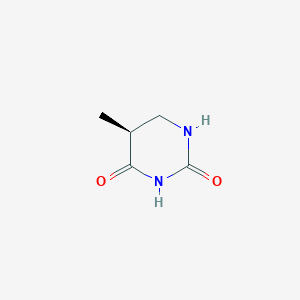| General Information of MET (ID: META00770) |
| Name |
Dihydrothymine
|
| Synonyms |
Click to Show/Hide Synonyms of This Metabolite
(-)-(S)-5,6-Dihydrothymine; (5S)-5-Methyl-1,3-diazinane-2,4-dione; 5,6-Dihydro-5-methyluracil; 5,6-Dihydrothymine; 5-Methyl-5,6-dihydrouracil; 5-Methyldihydropyrimidine-2,4(1H,3H)-dione; Dihydro-5-methyl-2,4(1H,3H)-pyrimidinedione; Dihydrothymine
|
| Source |
Endogenous;Escherichia Coli Metabolite;Food;Toxins/Pollutant;Microbial
|
| Structure Type |
Pyrimidines and pyrimidine derivatives (Click to Show/Hide the Complete Structure Type Hierarchy)
Organoheterocyclic compounds
Diazines
Pyrimidines and pyrimidine derivatives
|
| PubChem CID |
|
| HMDB ID |
|
| Formula |
C5H8N2O2
|
| Structure |
<iframe style="width: 300px; height: 300px;" frameborder="0" src="https://embed.molview.org/v1/?mode=balls&cid=676414"></iframe>
|
 |
|
3D MOL
|
2D MOL
|
|
Click to Show/Hide the Molecular/Functional Data (External Links/Property/Function) of This Metabolite
|
| KEGG ID |
|
| FooDB ID |
|
| ChemSpider ID |
|
| Physicochemical Properties |
Molecular Weight |
128.13 |
Topological Polar Surface Area |
58.2 |
| XlogP |
-0.6 |
Complexity |
155 |
| Heavy Atom Count |
9 |
Rotatable Bond Count |
N.A. |
| Hydrogen Bond Donor Count |
2 |
Hydrogen Bond Acceptor Count |
2 |
| Function |
Dihydrothymine (CAS: 696-04-8) is an intermediate breakdown product of thymine. Dihydropyrimidine dehydrogenase catalyzes the reduction of thymine into 5,6-dihydrothymine; then dihydropyrimidinase hydrolyzes 5,6-dihydrothymine into N-carbamyl-beta-alanine. Finally, beta-ureidopropionase catalyzes the conversion of N-carbamyl-beta-alanine into beta-alanine. When present at abnormally high levels, dihydrothymine can be toxic, although the mechanism of toxicity is not clear. In particular, patients with dihydropyrimidinase deficiency exhibit highly increased concentrations of 5,6-dihydrouracil and 5,6-dihydrothymine; and moderately increased concentrations of uracil and thymine can be detected in urine. Dihydropyrimidinase deficiency is a disorder that can cause neurological and gastrointestinal problems in some affected individuals. The most common neurological abnormalities that occur are intellectual disability, seizures, weak muscle tone (hypotonia), abnormally small head size (microcephaly), and autistic behaviours that affect communication and social interaction. Gastrointestinal problems that occur in dihydropyrimidinase deficiency include the backflow of acidic stomach contents into the esophagus (gastroesophageal reflux) and recurrent episodes of vomiting.
|
|
Regulatory Network
|
|
|
|
|
|
|
|
|
 click to show the details of this protein
click to show the details of this protein
 click to show the details of experiment for validating this pair
click to show the details of experiment for validating this pair

